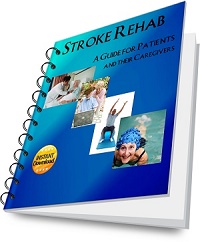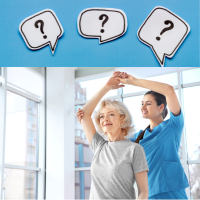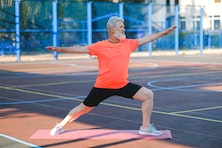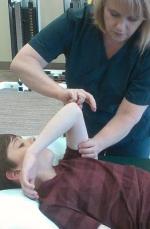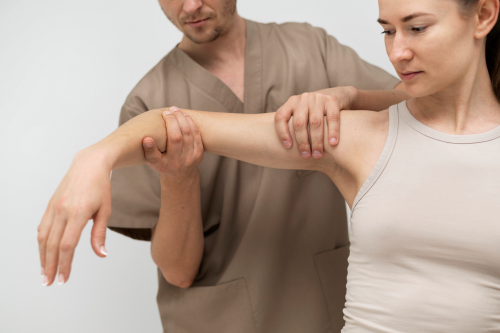Hypotonia
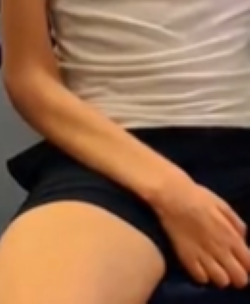 |
Hypotonia is low muscle tone or flaccidity that can occur from a stroke. It most commonly occurs right after a stroke and usually subsides but can linger in some patients indefinitely. It can affect the arm and/or leg. The arm will appear limp. |
In this flaccid stage of stroke, one should be careful in positioning the limbs to prevent injury. If the arm is flaccid, it can be supported on a pillow, tray, or arm trough/armrest. The lower extremity can be supported with a wheelchair footrest to keep the foot from being dragged under the wheelchair.
Recommended Treatment for Hypotonia
Recommended treatment during the flaccid or hypotonic stage includes:
1. Positioning of the affected limbs as described above
2. Weight-bearing to the affected limbs – this can be done with assist from a helper. Weight bearing for the arm can be done on a mat, the side of the bed, a ball, a table, etc. Weight bearing to the leg will occur when transferring from bed to chair or when learning to transfer and stand with the therapist.
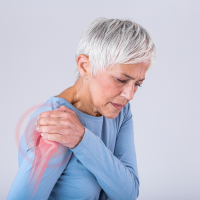
3. Passive range of motion in a pain-free zone – this means either having a helper move the affected extremities or using the strong arm to move the weak or paralyzed arm. See stroke-rehab.com/passive-range-of-motion.html to learn how to perform these type of exercises.
4. Relearning sitting balance with assistance from helper – learning to sit up using hands to help stabilize, then sitting up without hands, shifting weight side to side and forward/back
5. Muscle facilitation – (tapping, electrical stimulation, quick stretch)
6. Attempting movement with the affected extremities including activites like:
Trying to slide the arm across a table with a towel
Placing the hand on a ball and trying to roll the ball forward/back or side to side
Placing the hand on a cane with assist from a helper for grasp and then trying to push and pull the cane
Trying to slide the leg on a mat or bed when lying down
Trying to straighten the leg when sitting in a chair (or slide the foot on a towel on the floor)
7. Mental Imagery - The patient will imagine the movement needed to perform a task and rehearse it mentally. This technique has been used by athletes to improve their performance and has also been shown to be effective in helping stroke patients improve UE movement.
|
As an Amazon Associate, I earn from qualifying purchases |
8. Mirror Box Therapy - Using a mirror box (these can be bought or made), the patient slips the affected hand/arm inside the box and the non-affected hand/arm in front of the mirror on the outside of the box. The person moves the non-affected hand/arm or does various activities with it while looking in the mirror at the reflection. The reflection "tricks" the brain into thinking that the affected hand is working normally and helps to "rewire" the brain (this is a simplified explanation). |
More Info about Hypotonia
To find out more about treatment for hypotonia or flaccidity, visit https://www.stroke-rehab.com/Flaccid-Paralysis-Treatment.html
Newsletter Sign Up
Receive Stroke Recovery Tips, our online quarterly newsletter. Sign up below for free tips on exercises, resources, latest technology, apps, research and more!
To view past issues of Stroke Recovery Tips, visit https://www.stroke-rehab.com/Stroke-Recovery-Tips-BackIssues.html
As an Amazon Associate I earn from qualifying purchases.
- Home
- Flaccidity & Low Tone
Recent Articles
-
How to Make Neuroplasticity Repeatable On Demand
Submission from reader: Neuroplasticity is widely touted as a way for stroke survivors to recover. To make it repeatable on demand, what exact signal is -
Only Plays Internet Games and Nothing Else Three Years Post Stroke
Question: I know playing games for up to 8 hours on the internet is not healthy for anyone. Does anyone know how sitting all day long playing games on -
Sadness After Stroke
I Get Sad Question:I get so sad at times like I lost the old me, I was very active and now I’m not, I’ve had a complete meltdown and just sobbed. Answer: -
More damage done to paralyzed left arm as a result of carelessness.
Question: My husband suffered a stroke which caused his entire left side with no feeling or movement. Recently, my husband possibly could have been turned -
Shouting, Confusion, and Anger After Stroke
Question from reader: My mom had a stroke about a month ago. Physically she is improving, but she has bouts of anger, confusion (says weird things), and -
Cloudy vision after stroke
Question: My mother had a stroke 1 yr ago. It caused partial loss of vision on her right side. During a 4 day road trip, her vision would get cloudy and -
Flaccid Paralysis After Stroke
Learn about stroke treatment for flaccid paralysis after stroke. -
Vision Problems After Stroke
Answers to patients' questions about vision problems after stroke and treatment. -
Symptoms Getting Worse After Stroke
If you experience sudden declines or changes after stroke, you should seek medical attention. -
Flaccid Paralysis Treatment After Stroke: Questions and Answers
Answers to questions about flaccid paralysis treatment after stroke including home exercises and treatment ideas.



